Chapter 2: Shivaji Maharaj’s Legendary Coronation – The Birth of Swarajya
Chapter 2 : “From Warrior to King”
The last Chapter.
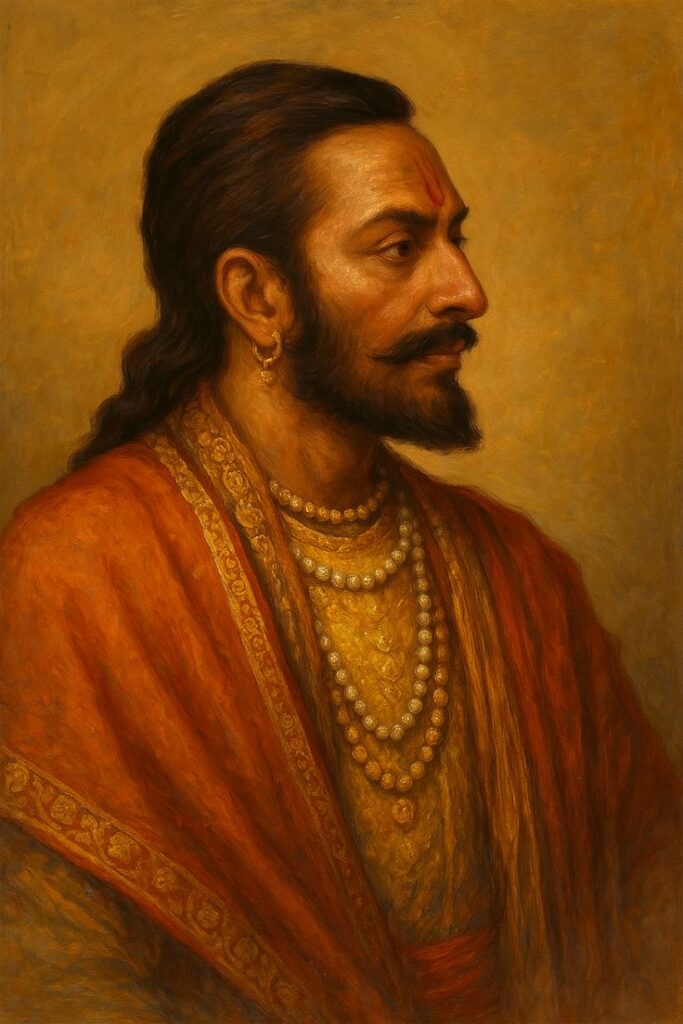
🛡️ Introduction
From Sword to Sovereignty – Shivaji Maharaj’s Unstoppable Rise
He wasn’t born into royalty—he carved it out of resistance. Shivaji Maharaj’s journey from a daring warrior to a crowned king is not just a tale of conquest, but a blueprint of leadership, vision, and cultural revival. Every fort he captured, every strategy he executed, every oath he took was a step toward Swarajya—a self-ruled nation built on pride, purpose, and protection.
In 1674, when Shivaji Maharaj was crowned at Raigad, it wasn’t just a coronation—it was a revolution. A Maratha warrior had risen to challenge centuries of foreign dominance, declaring that India could rule itself. His throne wasn’t inherited—it was earned through blood, intellect, and unwavering belief in his people.
This chapter dives deep into the transformation of Shivaji Maharaj—from battlefield tactician to sovereign ruler. It explores how his leadership redefined royalty, how his administration empowered the masses, and how his legacy continues to inspire creators, leaders, and rebels today. Because Shivaji Maharaj didn’t just build an empire—he built a mindset.
Table of Contents
🌊 Shivaji Maharaj’s Maritime Vision
“A Kingdom with a Sea Border Must Command Both Land and Water”
Though born in the rugged Sahyadri hills, Shivaji Maharaj saw beyond mountains—he saw the sea as a frontier of freedom. Long before modern naval doctrines emerged, he understood that coastal control was not optional—it was essential. His quote, “A kingdom with a sea border must command both land and water,” may not be recorded verbatim, but it’s deeply embedded in his actions, policies, and legacy.
This vision laid the foundation for India’s first structured, state-sponsored navy, turning the Maratha coast into a fortress of sovereignty.
🧠 Vision Behind the Quote
1.🌍 Geopolitical Understanding
- The Konkan coast was exposed to invasions from Portuguese, British, Siddis of Janjira, and Dutch fleets.
- Shivaji Maharaj realized that land-based forts alone couldn’t protect Swarajya.
- Without naval power, enemies could bypass defenses and strike directly via the sea.
💰 Economic Independence
- The Arabian Sea trade routes were lifelines for Maratha commerce.
- Foreign powers taxed, looted, or blockaded Indian ships.
- Shivaji’s navy protected merchants, stabilized revenue, and boosted local trade.
⚔️ Military Advantage
- Naval strength enabled coastal raids, blockades, and rapid troop movement.
- It gave Shivaji strategic superiority over land-bound empires.
- His navy became a mobile shield and sword for Swarajya.
🧱 Step-by-Step Creation of the Navy
⚔️ 1657–1660: Coastal Raids & Sea Awareness
- Raids on Kalyan and Dabhol exposed vulnerabilities along the coast.
- Threats from Siddis and Portuguese prompted early coastal defense planning.
- Shivaji began integrating sea strategy into land warfare.
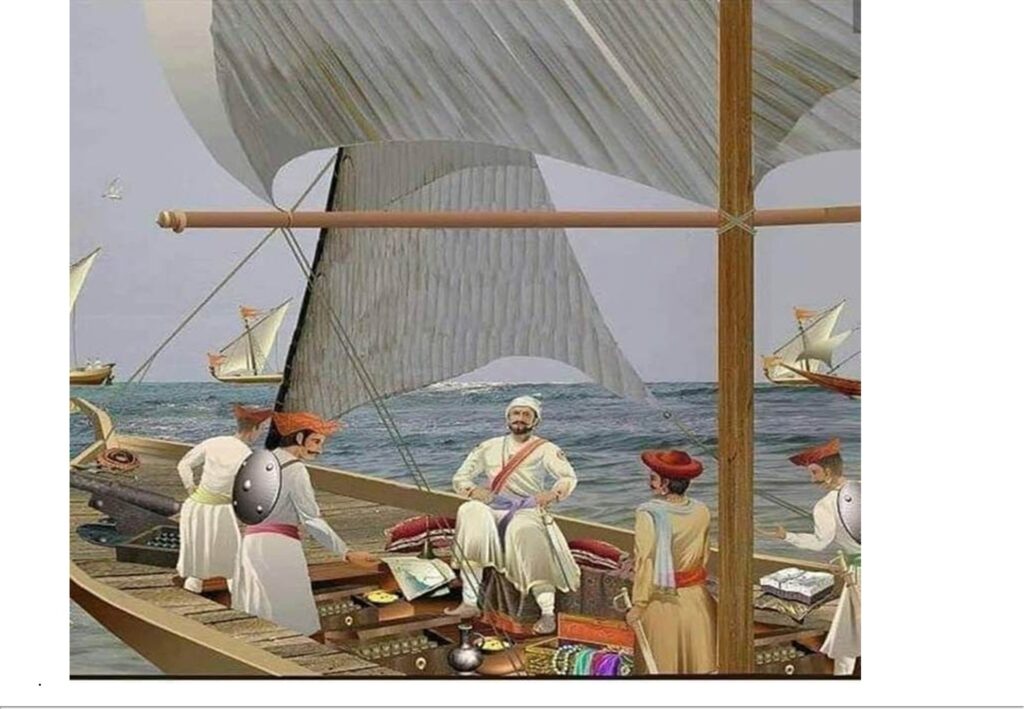
⚓ 1661–1664: Fort Building & Naval Bases
- Construction of Sindhudurg Fort began in 1664 under Hiroji Indulkar.
- Expansion of Vijaydurg, Padmadurg, Khanderi, and Underi fortified the coastline.
- These forts served as naval HQs, watchposts, and supply hubs.
🚢 1665–1667: Fleet Procurement & Training
- Shivaji acquired ships like Amstel from European traders.
- Indigenous shipbuilders were trained to craft gurabs (warships) and galivats (scouts).
- Maynak Bhandari was appointed as the first Sarkhel (Admiral)—a title created by Shivaji himself.
🔥 1668–1672: Naval Engagements & Dominance
- Maratha navy clashed with Siddis at Khanderi and Underi islands.
- They intercepted Portuguese cargo ships and blockaded enemy ports.
- This phase marked the rise of a true maritime force—agile, strategic, and sovereign.
👥 Key Naval Commanders
- Maynak Bhandari (Sarkhel) – Architect of Maratha naval warfare.
- Daryasarang – Led swift raids and coastal strikes.
- Kebaji Harad – Managed intelligence, logistics, and supply chains.
🛡️ Forts & Shipbuilding Infrastructure
- Sindhudurg Fort – Naval HQ with freshwater wells, granaries, and dry docks.
- Vijaydurg Fort – Featured underwater walls and ship repair facilities.
- Padmadurg, Khanderi, Underi – Strategic outposts for surveillance and defense.
- Shipyards were established in:
- Ratnagiri, Malvan, Dabhol – Known for quality timber, skilled craftsmen, and deep-water access.
⚔️ Naval Conflicts & Legacy
🇸🇮 Siddi Encounters
- Frequent clashes near Janjira.
- Marathas used smaller, faster ships to disrupt larger Siddi fleets.
🇵🇹 Portuguese Engagements
- Maratha navy seized cargo ships, defended ports like Dabul and Korlai.
- Asserted control over trade routes and coastal towns.
🇬🇧 British Skirmishes
- Early confrontations near Bombay and Bassein.
- British merchants in Surat were forced to acknowledge Maratha naval power.
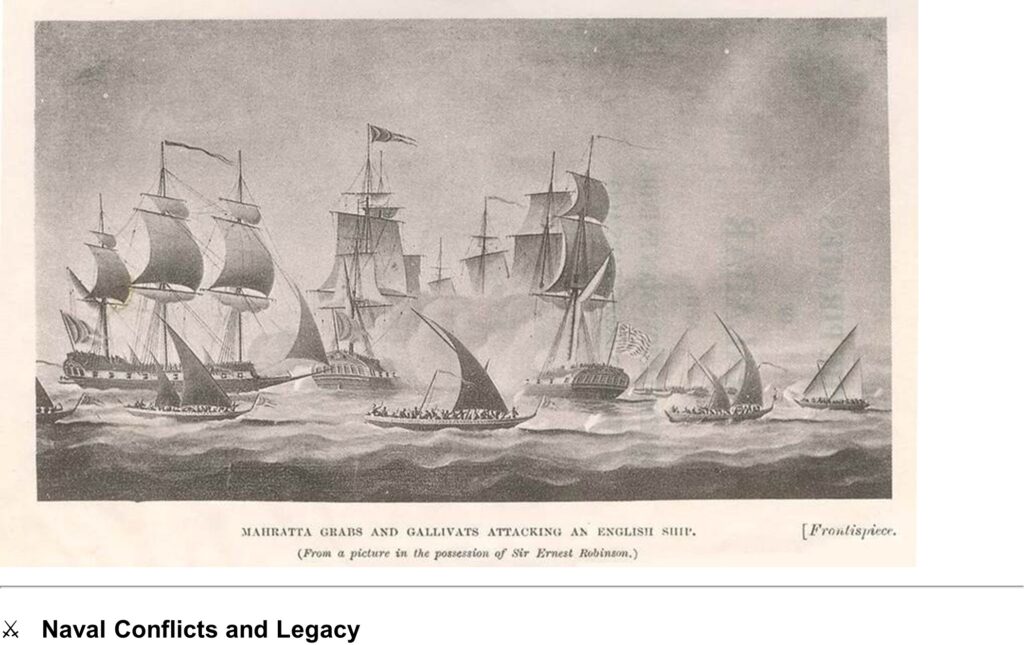
🌟 Lasting Impact
- Shivaji Maharaj established India’s first indigenous navy—not just for war, but for sovereignty.
- He instilled maritime awareness and self-reliance in Maratha governance.
- His legacy was carried forward by Kanhoji Angre, who expanded naval dominance.
- Today, the Indian Navy honors Shivaji Maharaj as the Father of Indian Naval Power.
📚 References
- Jadunath Sarkar – Shivaji and His Times
- G.S. Sardesai – New History of the Marathas
- Maharashtra Government – Shivaji Souvenir
- Naval History Division – Maritime Heritage of India
- V.K. Rajwade – Maratha Navy and Maritime Strategy (added for depth)
🗡️ Night Raid on Shaista Khan at Lal Mahal, Pune (January 5, 1663)
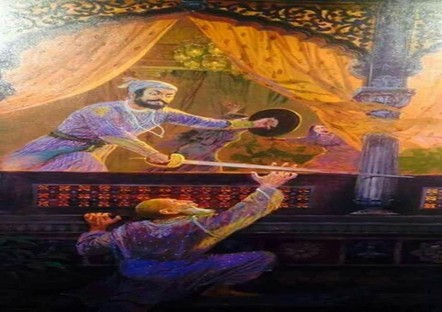
📜 Background & Context
By late 1662, Mughal general Shaista Khan had entrenched himself in Pune, operating under Emperor Aurangzeb’s direct orders to crush the rising Maratha power. His occupation was brutal—temples were desecrated, taxes were hiked, and Maratha morale was sinking. Shaista Khan even took residence in Lal Mahal, the childhood home of Shivaji Maharaj, adding insult to injury.
At just 31 years old, Shivaji Maharaj conceived a daring plan—not just to strike the enemy, but to send a message. A night raid on Lal Mahal would be more than revenge—it would be a psychological masterstroke to restore pride, shake Mughal confidence, and reignite the flame of Swarajya.
References: Jadunath Sarkar (Shivaji and His Times); G.S. Sardesai (New History of the Marathas); NCERT.
🏹 Forces & Key Planners
| Participant | Role & Contribution |
| Shivaji Maharaj | Supreme commander, strategist, and lead attacker |
| Baji Pasalkar | Led the main assault team into Lal Mahal |
| Bahirji Naik | Spymaster—provided palace layout, guard shifts, and intel |
| Fateh Singh Bhosle | Managed escape logistics and horse deployment |
| Yesaji Kank | Secured rear entrance and initiated diversionary fire |
| Military Band | Created chaos with drums and noise at the outer gate |
- Estimated Strength: ~150–200 elite Maratha raiders
- Preparation Time: Weeks of surveillance, disguise planning, and route mapping
References: Govind Pansare (Life and Times of Shivaji); NCERT.
🎯 Execution & Outcome
- Infiltration
Disguised as laborers and wedding guests, the Maratha raiders scaled the walls using grappling hooks and entered through an unguarded rear gate. Timing was critical—every second counted. - Targeted Strike
Shivaji Maharaj personally led the charge into the Zenana Mahal (women’s quarters), where Shaista Khan was resting. In the chaos, Shivaji struck and severed three fingers of the Mughal general. Khan escaped narrowly, but his pride was shattered. - Diversion & Escape
Yesaji Kank’s team lit fires and created confusion at the rear. Meanwhile, the military band played loud drums at the main gate, drawing guards away from the real action. Within 20 minutes, the Marathas withdrew, sustaining only 5–10 casualties. - Aftermath
Shaista Khan, humiliated and wounded, was recalled to Aurangzeb’s camp. He never again commanded in the Deccan. The raid became legendary—proof that Mughal might could be outwitted by Maratha brilliance.
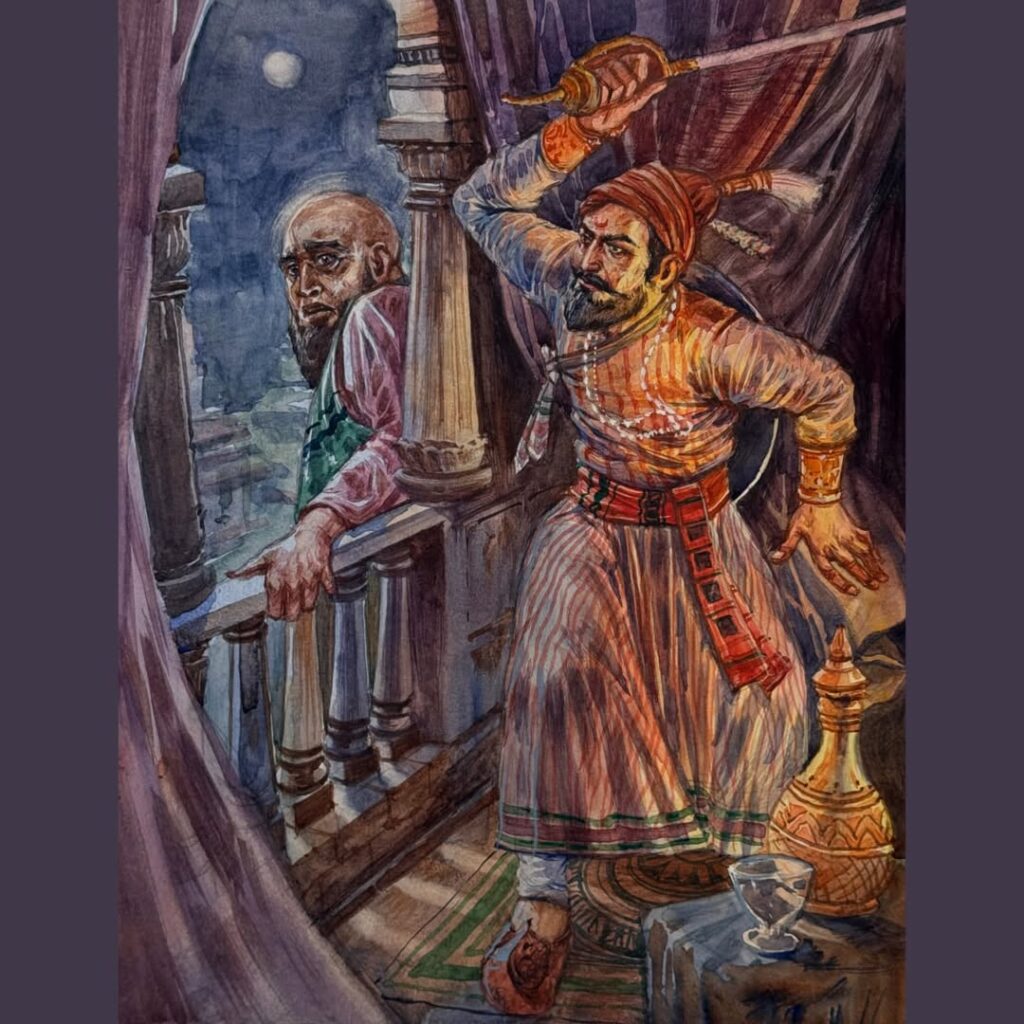
🌟 Strategic Significance
- ✅ Tactical Genius: The raid showcased Shivaji Maharaj’s mastery of guerrilla warfare and psychological strategy.
- ✅ Symbolic Victory: Striking Lal Mahal—his own childhood home—was a reclaiming of Maratha pride.
- ✅ Political Ripple: Local chieftains, inspired by the audacity, began aligning with the Swarajya movement.
- ✅ Mughal Disruption: Aurangzeb was forced to redeploy troops, easing pressure on Maratha frontiers and allowing Shivaji to regroup and expand.
🧠 Legacy of the Raid
This wasn’t just a military operation—it was a message. Shivaji Maharaj proved that courage, planning, and purpose could defeat even the most powerful empire. The Lal Mahal raid remains one of the boldest tactical strikes in Indian history—a masterclass in leadership, timing, and fearless execution.
🗡️ Night Raid on Surat: Shivaji Maharaj’s Strategic Strike
January 26, 1664 – When Swarajya Stormed the Mughal Purse
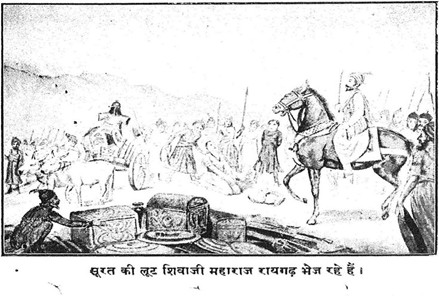
📜 Background & Context
By early 1664, Shivaji Maharaj had set his sights on Surat, the Mughal Empire’s wealthiest port city. Known for its bustling trade in spices, silks, and precious metals, Surat was a hub for merchants from Persia, Portugal, Britain, and the Dutch East India Company. But beneath its prosperity lay Mughal arrogance—oppressive taxation, corrupt officials, and a disregard for local grievances.
Shivaji Maharaj objective was clear:
- Seize wealth to fund Swarajya
- Punish Mughal officials for their tyranny
- Send a message to Aurangzeb and foreign powers that Maratha strength could reach even the empire’s economic heart.
This wasn’t just a raid—it was a strategic strike designed to shake the Mughal treasury and elevate Maratha prestige.
🏹 Forces & Key Commanders
| Participant | Role & Contribution |
| Shivaji Maharaj | Supreme commander and strategist |
| Bahirji Naik | Spymaster—gathered intelligence on city defenses |
| Netaji Palkar | Led naval detachment to blockade the Tapi river |
| Kanhoji Jedhe | Coordinated land forces and diversionary attacks |
| Sambhaji Bhosale | Led raid squads into merchant quarters |
| Senior Mavlas (~500) | Elite strike teams for looting and crowd control |
References: Govind Pansare (Life and Times of Shivaji); NCERT
🎯 Execution & Tactics
- Intelligence Gathering
Months before the raid, Bahirji Naik’s spy network mapped Surat’s defenses—gate timings, guard rotations, merchant warehouse locations, and escape routes. This groundwork ensured precision and speed. - Coordinated Assault
At dawn on January 26, 1664, Shivaji split his forces:
- Netaji Palkar’s naval units blockaded the Tapi river, cutting off reinforcements by sea.
- Kanhoji Jedhe and Sambhaji Bhosale led land squads that breached city gates and launched surprise attacks.
- Targeted Plunder
The Mavlas looted Mughal warehouses, merchant homes, and treasury vaults—collecting gold, silver, silks, weapons, and horses. Mughal officers known for abusing locals were publicly humiliated, reinforcing Shivaji’s image as a just leader. - Swift Withdrawal
Within 48 hours, Shivaji’s forces withdrew with an estimated loot of ₹15 lakh (a massive sum in 17th-century India). The operation was so swift and disciplined that Mughal reinforcements arrived too late to retaliate.
🌟 Strategic Impact
- ✅ Economic Shock to the Mughals
The raid exposed the vulnerability of Mughal trade centers and dented imperial confidence. - ✅ Funding Swarajya’s Expansion
The loot financed future military campaigns, fort construction, and naval development—including Sindhudurg and Vijaydurg. - ✅ Diplomatic Leverage
European merchants began to respect and negotiate with the Marathas, recognizing their growing influence. - ✅ Rise in Reputation
Shivaji Maharaj’s daring strike elevated his status as a master tactician, earning admiration from coastal chiefs and fear from imperial commanders.
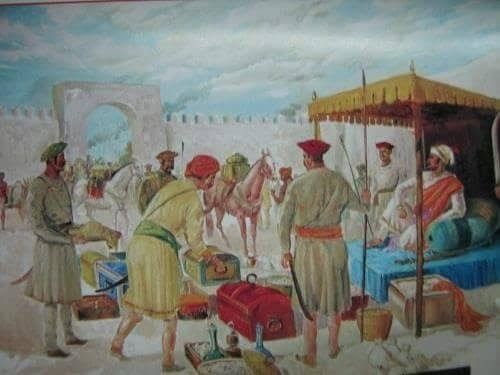
🧠 Legacy of the Surat Raid
The Surat raid wasn’t just a military success—it was a masterclass in strategic warfare. Shivaji Maharaj proved that speed, intelligence, and purpose could overpower even the richest cities. His ethical conduct—sparing religious sites and civilians—set him apart from typical raiders. Today, the raid stands as a symbol of Maratha audacity, precision, and vision.
🏯 Agra Imprisonment and Betrayal
1666 – When Diplomacy Turned into Deceit
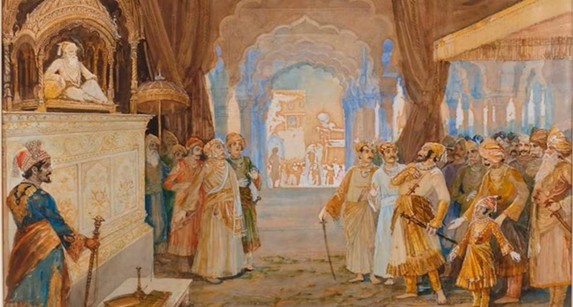
📜 Background & Context
n the summer of 1666, Emperor Aurangzeb extended an invitation to Shivaji Maharaj to visit the Mughal court in Agra, under the pretext of honoring him for his military achievements. The Maratha king, having recently signed the Treaty of Purandar, agreed to attend—accompanied by his young son Sambhaji Maharaj and a small delegation.
But the Mughal court had other plans.
Upon arrival, Shivaji Maharaj was deliberately insulted—placed among low-ranking nobles, far from his rightful position as a sovereign ruler. This was not a mistake; it was a calculated move to undermine his status, provoke humiliation, and test his submission.
When Shivaji protested the insult, Aurangzeb ordered his house arrest, effectively turning a diplomatic gesture into a political trap. The Maratha delegation was stunned. It became clear that the Mughal court had no intention of letting Shivaji return safely.
🎯 Political Context
- Aurangzeb feared the rising influence of the Marathas and sought to neutralize Shivaji Maharaj.
- The plan was to either convert him to Islam or quietly execute him, removing a major threat to Mughal dominance.
- The invitation was a mask for betrayal, wrapped in the language of diplomacy.
🧠 The Ordeal Inside Agra Fort
For several weeks, Shivaji Maharaj and Sambhaji were kept under tight surveillance, surrounded by Mughal guards. The psychological pressure was immense—constant fear of assassination, humiliation, and political isolation.
Yet, Shivaji Maharaj remained composed. He refused to bow, refused to break, and began planning one of the most daring escapes in Indian history.
🗡️ The Great Escape
On August 17, 1666, Shivaji Maharaj executed a brilliant plan:
- Disguise & Deception
Shivaji and Sambhaji disguised themselves as servants. They hid inside large fruit and sweet baskets that were routinely sent out of the fort as part of daily deliveries. - Logistics & Timing
The escape was timed with precision. The baskets were carried out by trusted aides, bypassing Mughal guards who had grown accustomed to the routine. - Escape Route
From Agra, Shivaji took a circuitous route through Mathura, avoiding major Mughal checkpoints. He traveled incognito, often switching disguises and resting in safe houses. - Return to Swarajya
After weeks of cautious travel, Shivaji Maharaj reached Maharashtra, greeted by his people as a hero. His escape was not just a survival—it was a statement.
👥 Key Figures Who Helped
- Bahiroji Pingale – Managed logistics and coordinated safe passage.
- Jiva Mahala – Shivaji’s loyal bodyguard, disguised and traveled with him.
- Balaji Avji – Mastermind behind the disguise strategy and exit planning.
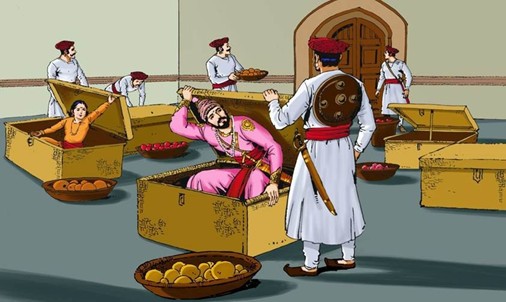
🌟 Strategic Impact
- ✅ Aurangzeb’s Humiliation
The emperor’s plan failed spectacularly. Shivaji’s escape became a symbol of Mughal incompetence and Maratha brilliance. - ✅ Maratha Morale Surge
The daring escape boosted Swarajya’s morale, proving that Shivaji Maharaj was unstoppable—even in the heart of enemy territory. - ✅ Legacy of Ingenuity
The Agra escape became a legend of strategic genius, studied and admired for centuries. - ✅ Political Clarity
Shivaji Maharaj now knew: Delhi could never be trusted. Swarajya had to be built independently, without compromise.
🔥 Legacy of the Betrayal
The Agra imprisonment wasn’t just a betrayal—it was a turning point. It exposed the true face of Mughal politics and solidified Shivaji Maharaj’s resolve to build an empire rooted in self-respect, sovereignty, and strategy.
His escape was not just physical—it was philosophical. A declaration that Maratha pride could not be caged, and that Swarajya was not negotiable.
🏰 1670 – Recapture of 23 Forts
Shivaji Maharaj’s Tactical Comeback That Redefined Swarajya
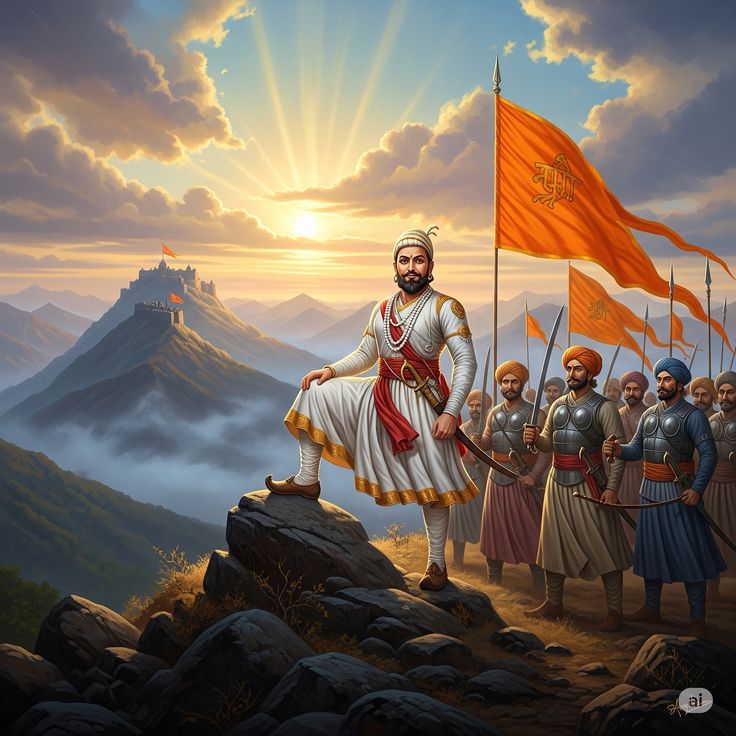
📜 Introduction: The Comeback Begins
The year was 1670. Shivaji Maharaj had returned from the Mughal court after his daring escape from Agra in 1666. The Treaty of Purandar (1665) had forced him to surrender 23 forts to the Mughals—a bitter compromise made under pressure. But Shivaji wasn’t defeated. He was recalibrating.
By 1670, the time for diplomacy was over. The Maratha lion roared again. In a swift and calculated campaign, Shivaji Maharaj recaptured all 23 forts, restoring Maratha dominance across the Western Deccan. This wasn’t just a military operation—it was a statement: Swarajya will not be surrendered. It will be reclaimed.
🧠 Strategic Context
- Purandar Treaty Fallout: Shivaji had ceded forts and territory to buy time and protect his people.
- Aurangzeb’s Betrayal: The Agra imprisonment proved that Mughal diplomacy was a trap.
- Rebuilding the Maratha Army: Shivaji used the years post-Agra to regroup, train, and prepare for a full-scale resurgence.
🏹 Key Objectives of the Campaign
- ✅ Reclaim strategic forts surrendered under Purandar
- ✅ Restore Maratha morale and territorial integrity
- ✅ Challenge Mughal authority in the Deccan
- ✅ Reassert Shivaji’s sovereignty and leadership
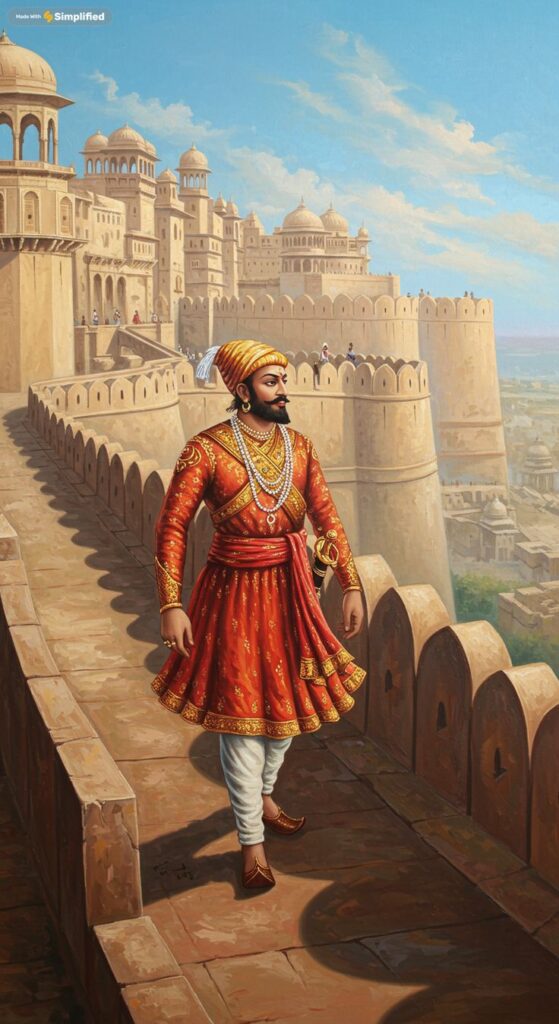
⚔️ Step-by-Step Campaign Breakdown
Mobilization Begins (Early 1670)
Shivaji Maharaj began rallying his trusted commanders and Mavla warriors. Secret messages were sent to local chieftains. Supplies were stockpiled. Guerrilla units were activated across the Sahyadris.
Surprise Strikes & Fort Raids
Using speed, stealth, and terrain mastery, Shivaji launched simultaneous raids on multiple forts. These included:
- Purandar
- Sinhagad
- Rajgad
- Torna
- Rohida
- Chakan
- Kondhana (later renamed Sinhagad)
- Lohagad, Visapur, and more
Each fort was targeted with precision—often at night or during festivals when Mughal defenses were relaxed.
Local Support & Intelligence
Villagers, farmers, and local leaders supported the Maratha resurgence. Bahirji Naik’s spy network provided intel on troop movements, fort layouts, and weak points.
Minimal Casualties, Maximum Impact
Shivaji’s tactics focused on quick victories with minimal bloodshed. Mughal garrisons were overwhelmed, and many surrendered without prolonged conflict.
Symbolic Victories
The recapture of Sinhagad, where Tanaji Malusare had once laid down his life, was especially symbolic. It marked the emotional return of Maratha pride.
👥 Key Commanders Involved
- Moropant Pingle – Managed logistics and troop coordination
- Netaji Palkar – Led cavalry raids and fort sieges
- Bahirji Naik – Provided critical intelligence
- Tanaji’s kin and Mavla units – Played key roles in terrain-based warfare
🌟 Strategic Impact
- ✅ Shattered Mughal Confidence: Aurangzeb’s grip on the region weakened.
- ✅ Inspired Future Campaigns: Set the stage for further expansion, including the coronation in 1674.
- ✅ Reignited Maratha Spirit: The people saw their king rise again—stronger, smarter, and unstoppable.
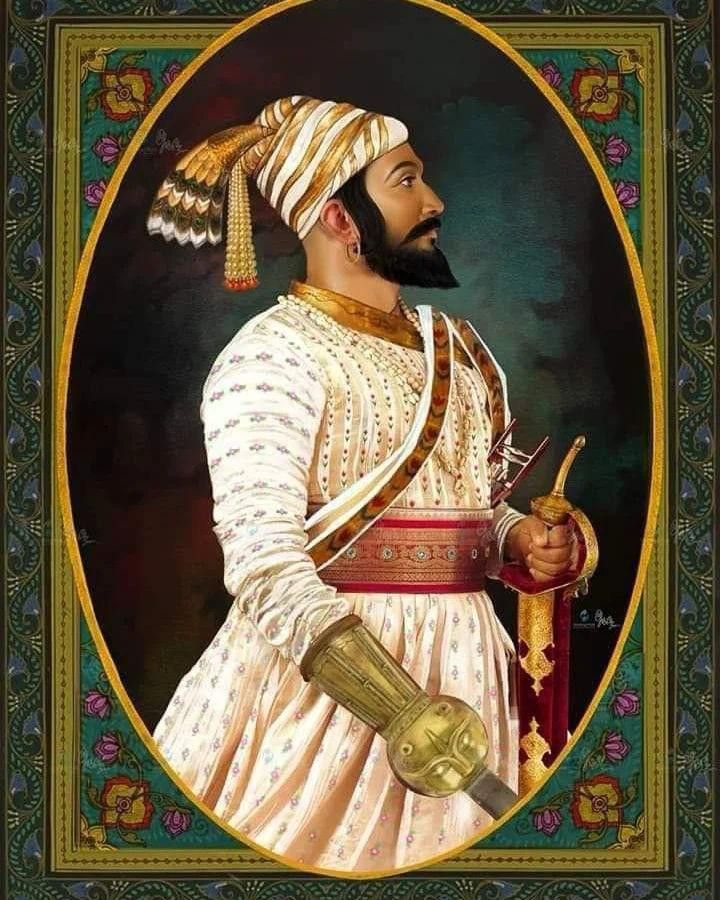
🔥 Legacy of the Recapture
The 1670 campaign wasn’t just about forts—it was about freedom, pride, and purpose. Shivaji Maharaj proved that Swarajya could be reclaimed, even after forced surrender. His comeback became a blueprint for resistance movements across India.
This chapter in history reminds us:
“True leaders don’t just win battles—they win back what was lost.”
👑 Coronation: Becoming Chhatrapati (1674)
Shivaji Maharaj’s Rise from Warrior to Sovereign
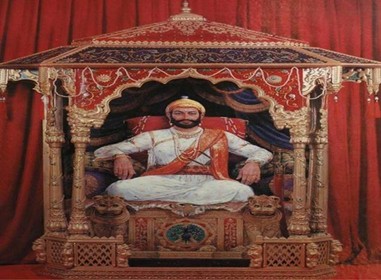
📜 Historical Moment
On June 6, 1674, atop the majestic Raigad Fort, Shivaji Maharaj was formally crowned Chhatrapati in a grand Vedic ceremony. The atmosphere was electrifying—tens of thousands of Marathas from across the Deccan, including soldiers, farmers, nobles, and artisans, gathered to witness their hero ascend from warrior to sovereign.
👑 Meaning of Chhatrapati
- Literal Translation:
Chhatra (छत्र) means “umbrella” or “canopy” — a traditional symbol of royal protection and sovereignty.
Pati (पति) means “lord” or “master”. - Combined Meaning:
Chhatrapati translates to “Lord of the Umbrella” or “Sovereign Ruler” — symbolizing a king who offers protection, commands authority, and rules independently.
🧘 Rituals & Symbols
- 108 sacred pots of water from holy rivers across India were poured over Shivaji’s head, symbolizing pan-Indian unity and sanctity.
- He received the Janeu (sacred thread) and was declared a Kshatriya, affirming his rightful place among Hindu rulers.
- New golden coins were minted bearing his emblem—the tiger, representing courage and sovereignty.
🏹 People & Soldiers Involved
- Over 50,000 attendees, including 15,000 soldiers from various Maratha contingents.
- A ceremonial guard of 5,000 cavalrymen and 2,000 infantry formed the honor escort.
- Around 3,000 musicians, priests, and artisans participated in the rituals and festivities.
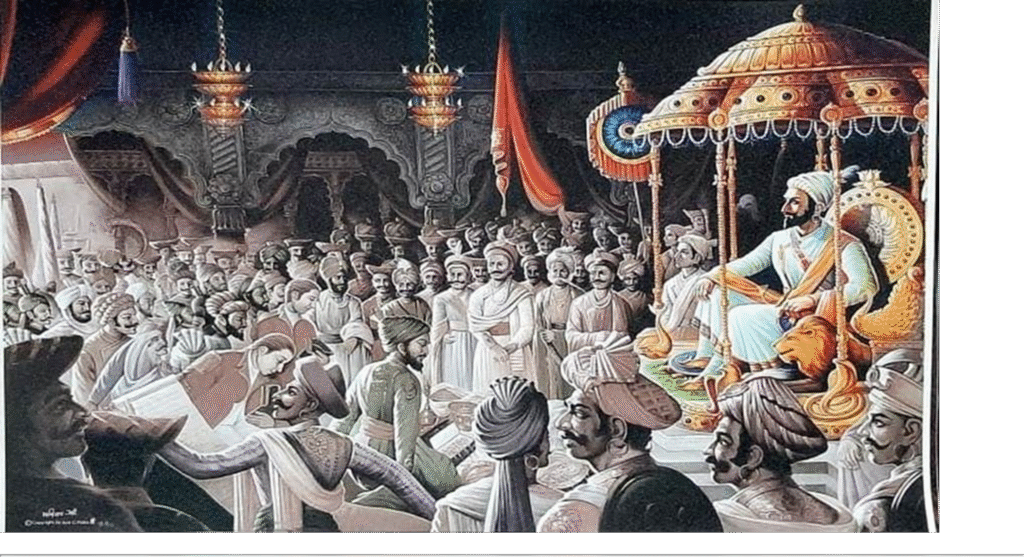
📖 Role of Pandit Gaga Bhatt
- Pandit Gaga Bhatt of Varanasi, a renowned Brahmin scholar, was specially invited.
- He conducted the Vedic rituals, authenticated Shivaji’s Kshatriya lineage, and recited the coronation mantras.
- After the ceremony, he composed a Sanskrit eulogy praising Shivaji’s virtues, which was preserved in royal archives.
🎉 Public Fervor
- Village drums and conches echoed across the hills as people chanted “Har Har Mahadev!”
- Women showered flowers, priests chanted Vedic mantras, and blessings were invoked for the new kingdom.
- Artisans and poets composed spontaneous hymns celebrating Swarajya, marking a cultural renaissance.
🧠 Shivaji Maharaj’s Emotions
- Shivaji stood with a calm yet radiant smile, his eyes reflecting gratitude and resolve.
- In his coronation address, he spoke of dharma, justice, and service to the people, visibly moved by the devotion around him.
- He humbly declared:
“This coronation is not for me, but for my people. I am merely a servant of Swarajya.”
💺 Creation of the Coronation Throne
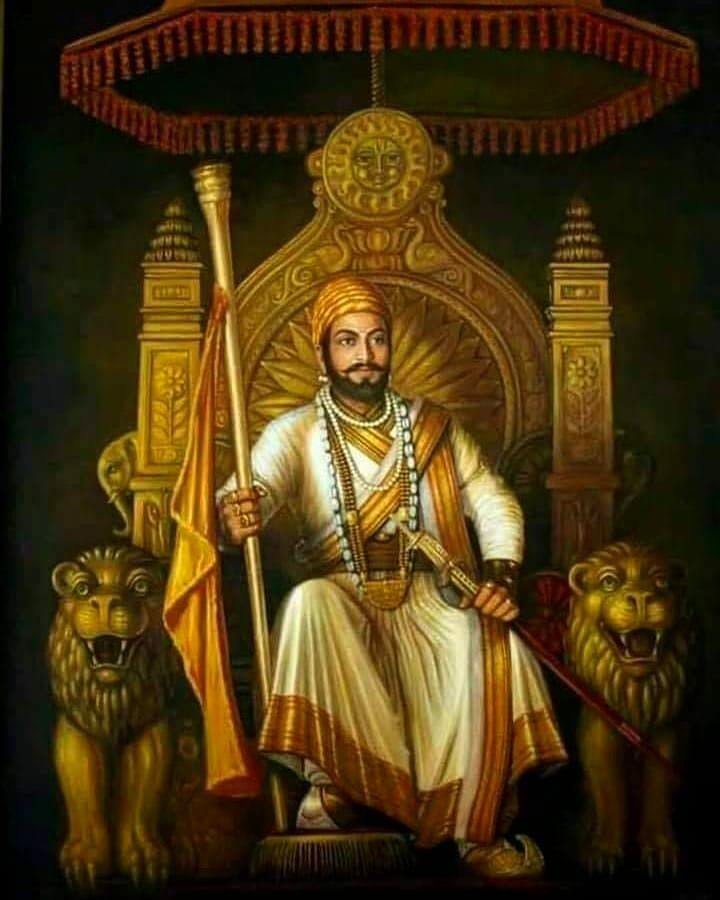
- Design & Materials: Crafted from teakwood, overlaid with gold plating, and inlaid with rubies, emeralds, and pearls—symbolizing prosperity and divine right.
- Artisans & Craftsmen: Built by carpenters from Saswad and goldsmiths from Pune, led by master craftsman Sambhaji Shinde.
- Cost & Contributions: Funded by the state treasury and voluntary donations from Maratha sardars—an estimated 50,000 huns (gold coins) were pooled.
- Weight: Approximately 250 kilograms, including gold plating and gemstones.
- Symbolism:
- Tiger motifs on the arms represented courage.
- Lotus base denoted purity of purpose.
- Emblems of the Bhavani sword and Maratha sun symbolized righteous power and fearless spirit.
- People Involved: Over 200 artisans, 150 goldsmiths, 50 gem-setters, and 100 laborers contributed—showcasing collective effort across social strata.
🌍 Presence at Raigad
- Total attendance: ~50,000 people
- Maratha Sardars: Around 100 prominent chiefs were present
- Foreign Guests: 12 envoys from Arab, Persian, British, and Portuguese delegations
- Brahmins & Scholars: Over 100 Vedic scholars from Kashi and South India attended
The grandeur of the event drew crowds from across the Indian subcontinent. Foreign envoys, Hindu scholars, and thousands of citizens witnessed this historic occasion.
🔱 Rituals of Coronation
- Rajyatilak: Ritual bath with Ganga water, crown placement, and conch-blowing
- Throne Ascension: Seated on the golden throne
- Vedic Chanting: 11 Brahmins performed the coronation with sacred mantras
- Shravan Vach: Shivaji affirmed his gotra, varna, and ancestral customs, establishing his Kshatriya identity
Pandit Gaga Bhatt led the rituals to affirm Shivaji Maharaj Kshatriya lineage—a crucial step to legitimize his kingship among Indian monarchs.
👩 Jijamata’s Emotions
“Jijamata, with tears of pride and joy, witnessed her son crowned. For her, it was the culmination of years of struggle and the birth of Swarajya.”
🎊 Celebrations and Festivities
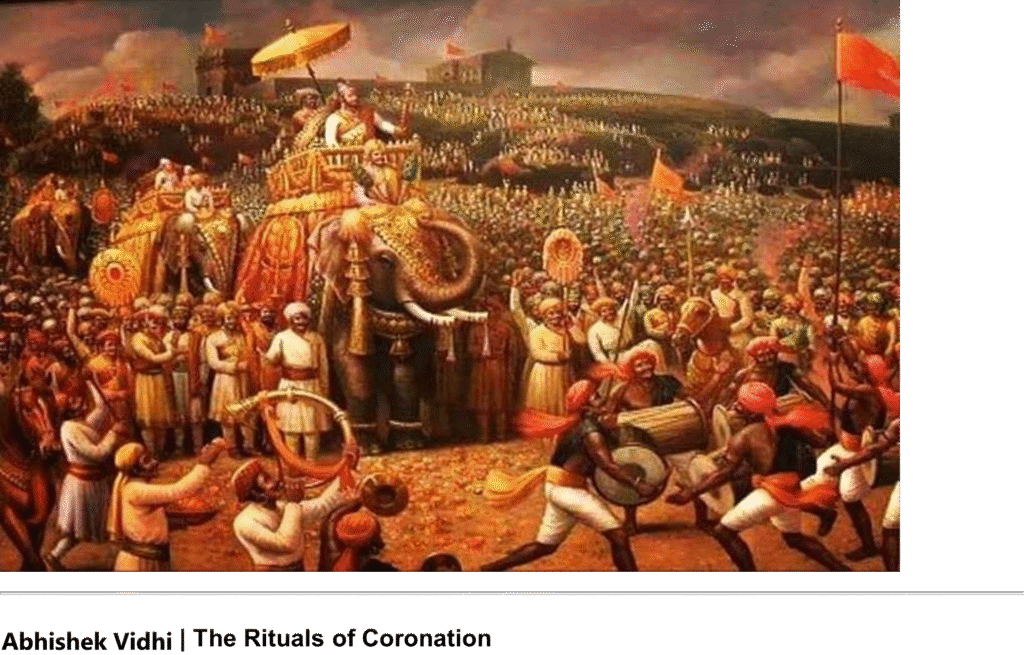
- 9-day festival: Featuring drama, kirtan, and martial arts competitions
- Total cost: Estimated at 16 lakh hons
- Food & Drink: Over 100 varieties of vegetarian and non-vegetarian dishes served
“The entire Raigad Fort was adorned with flowers and lights. Celebrations lasted nine days, filled with music, dance, and traditional martial arts.”
🧭 Conclusion
“Shivaji Maharaj’s coronation was not just the crowning of a king—it was the honoring of a nation’s soul.
It marked the formal birth of Hindavi Swarajya, a declaration of independence from Mughal dominance, and a defining moment in Indian history.”
📜 Administration & Governance | प्रशासन और नीति
Shivaji Maharaj’s Vision for a Just, Efficient, and Independent Swarajya
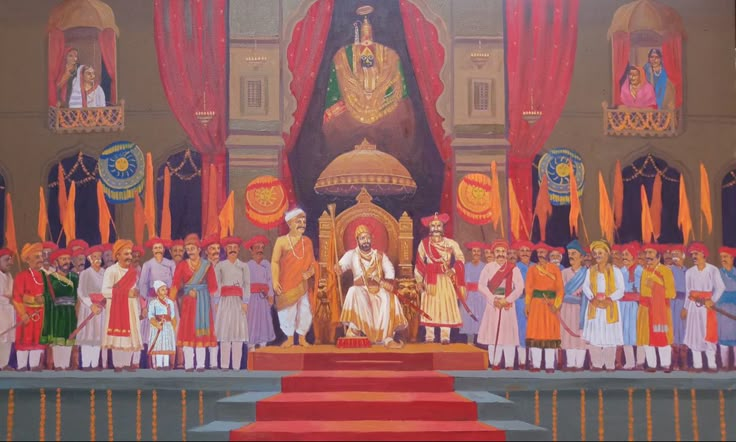
🧠 Step 1: Formation of the Ashtapradhan Mandal
To ensure smooth governance and prevent power centralization, Shivaji Maharaj created the Ashtapradhan Mandal—a council of eight ministers, each with a specific portfolio.
| Minister Title | Role & Responsibility | Key Figure |
| Peshwa | Prime Minister – Head of administration | Moropant Trimbak Pingle |
| Amatya | Finance Minister – Managed treasury and audits | Ramchandra Pant Amatya |
| Sachiv | Secretary – Oversaw royal correspondence | Annaji Datto |
| Mantri | Chronicler – Maintained records and archives | Raghunath Narayan Hanmante |
| Senapati | Commander-in-Chief – Led military operations | Netaji Palkar, Hambirrao Mohite |
| Sumant | Foreign Minister – Managed diplomacy | Nilakanth Moreshvar Pingale |
| Nyayadhish | Chief Justice – Oversaw legal matters | Gopinath Ganesh (Dharmadhikari) |
| Panditrao | Religious Affairs – Managed temple grants | Niraji Raoji |
✅ Impact: This council ensured division of power, accountability, and specialized governance.
💰 Step 2: Revenue System – Chauth & Sardeshmukhi
To fund administration and military campaigns, Shivaji Maharaj introduced two key taxes:
- Chauth (25%): A protection levy collected from coastal territories.
- Sardeshmukhi (10%): An additional tax on lands under nominal Mughal or Sultanate control.
✅ Impact: These taxes created a stable revenue stream without burdening farmers, and asserted Maratha authority over semi-autonomous regions.
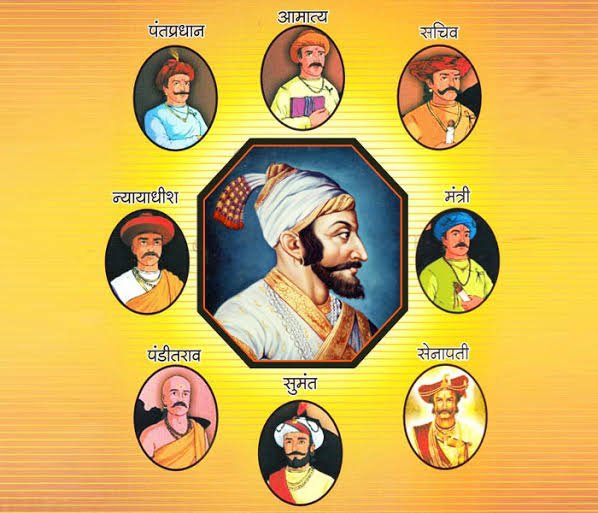
⚖️ Step 3: Judicial & Military Reforms
- Kulkul (Local Assemblies): Village councils handled grassroots justice, ensuring quick and fair resolutions.
- Standing Cavalry (Havaldar Units): Permanent cavalry units were formed for rapid deployment and border defense.
- Standardized Training: Drill manuals and codified tactics ensured discipline, unity, and battlefield efficiency.
✅ Impact: These reforms built a responsive justice system and a professional, agile military.
🕊️ Step 4: Religious Tolerance & Harmony
Shivaji Maharaj upheld communal harmony by:
- Patronizing temples, mosques, and Jain mathas.
- Granting land endowments to religious institutions of all sects.
- Respecting all faiths while promoting Hindavi Swarajya rooted in dharma.
✅ Impact: This fostered unity across communities and earned Shivaji respect from diverse groups.
🛡️ Step 5: Anti-Corruption Measures
To maintain integrity in governance:
- Regular audits were conducted by the Amatya and Nyayadhish.
- Harsh penalties were imposed for embezzlement—ranging from fines to imprisonment.
- Public hearings allowed citizens to voice grievances and ensured transparency.
✅ Impact: These measures built a trustworthy administration and reinforced ethical leadership.
🔚 Conclusion
Shivaji Maharaj’s governance wasn’t just about ruling—it was about serving Swarajya with justice, efficiency, and vision. His administrative model blended Vedic wisdom, military innovation, and grassroots empowerment, laying the foundation for a resilient Maratha state.
🛡️ Southern Conquests of Shivaji Maharaj
1676–1677: Expanding Swarajya Beyond Maharashtra
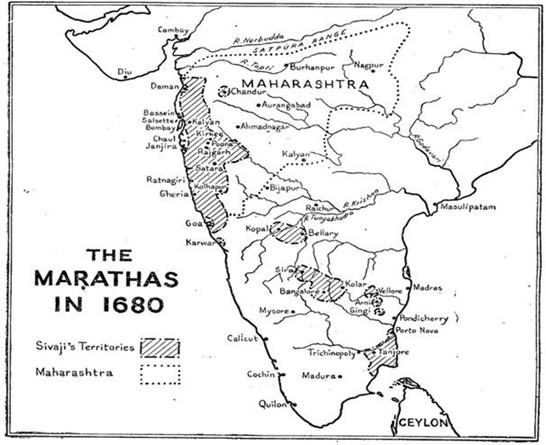
📜 Introduction: A New Horizon for Swarajya
After his coronation in 1674, Chhatrapati Shivaji Maharaj turned his gaze southward. His vision was clear: Swarajya must not be confined to Maharashtra—it must extend across the Indian subcontinent. The southern campaigns were not just military expeditions; they were strategic moves to challenge Mughal dominance, weaken the Adilshahi Sultanate, and secure economic and territorial strength.
🗺️ Strategic Objectives
- Challenge Adilshahi Rule: The Adilshahi Sultanate in Karnataka was weakening. Shivaji saw an opportunity to dismantle their hold and absorb key territories.
- Secure Trade Routes: Control over southern ports and inland trade centers would boost Swarajya’s economy.
- Buffer Against Mughals: Establishing Maratha presence in the south would prevent Mughal expansion and create a defensive shield for future generations.
📆 Step-by-Step Campaign Breakdown
1️⃣ 1676 – Preparation and Diplomacy
- Shivaji Maharaj allied with the Qutb Shahi Sultanate of Golconda (Hyderabad) to gain safe passage and logistical support.
- He avoided direct conflict with Bijapur by diplomatically playing Golconda and Bijapur against each other.
- This alliance gave him access to resources, intelligence, and strategic corridors into Karnataka and Tamil Nadu.
2️⃣ Battle of Jinji Fort (Tamil Nadu)
- Jinji Fort, located in present-day Tamil Nadu, was a massive fortress with natural defenses.
- Shivaji launched a surprise attack, capturing the fort and establishing it as a southern capital—especially useful during later Mughal pressure on Raigad.
- Jinji became a symbol of Maratha reach and resilience.
3️⃣ Siege of Vellore Fort
- Vellore was an ancient and heavily fortified Mughal stronghold.
- Shivaji’s forces laid siege and successfully captured the fort, giving the Marathas a firm foothold in Tamil Nadu.
- This victory disrupted Mughal logistics and boosted Maratha morale.
4️⃣ March to Tanjavur
- Shivaji advanced toward Tanjavur, a region formerly ruled by the Nayaks.
- The local population welcomed him, drawn by his fair taxation, respect for temples, and Hindu leadership.
- This peaceful integration showcased Shivaji’s diplomatic finesse and cultural sensitivity.
5️⃣ Expansion into Karnataka
- Shivaji targeted key regions like Bangalore, Kolar, and Sira.
- Some territories were won through battle, while others were absorbed via negotiation and alliances.
- This phase expanded Swarajya into the heart of southern India.
⚔️ Key Commanders (Senapatis) Involved
- Netaji Palkar – Veteran cavalry commander, led rapid strikes and flanking maneuvers.
- Moropant Trimbak Pingle – First Peshwa, managed finances and logistics.
- Hambirrao Mohite – Head of infantry, known for fierce battlefield leadership.
- Annaji Datto – Oversaw administrative integration and local governance.
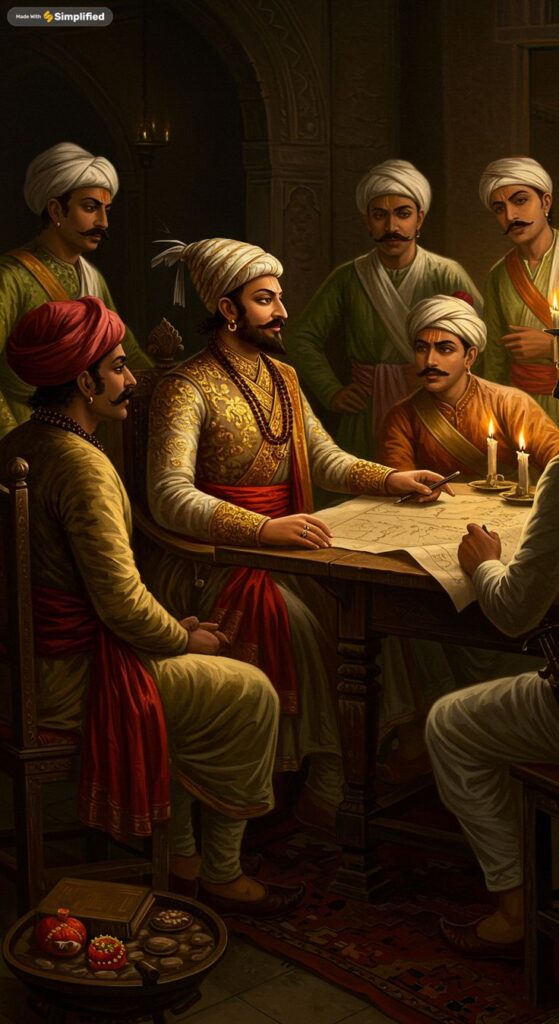
🤝 Local Support & Integration
- Shivaji gained support from discontented Nayakas and Hindu chieftains who opposed Mughal and Adilshahi rule.
- He respected local customs, temples, and religious institutions, earning trust and loyalty.
- His fair taxation policies and non-interference in local traditions made him popular among southern communities.
🎯 Results and Impact
- ✅ Established Maratha Presence: Swarajya now extended deep into southern India.
- ✅ Strategic Southern Front: These territories later helped Sambhaji Maharaj defend against Aurangzeb’s invasions.
- ✅ Secured Forts & Trade Centers: Control over Jinji, Vellore, and Tanjavur boosted military and economic strength.
- ✅ Pan-Indian Prestige: Shivaji Maharaj’s reputation soared—he was now seen as a national leader, not just a regional king.
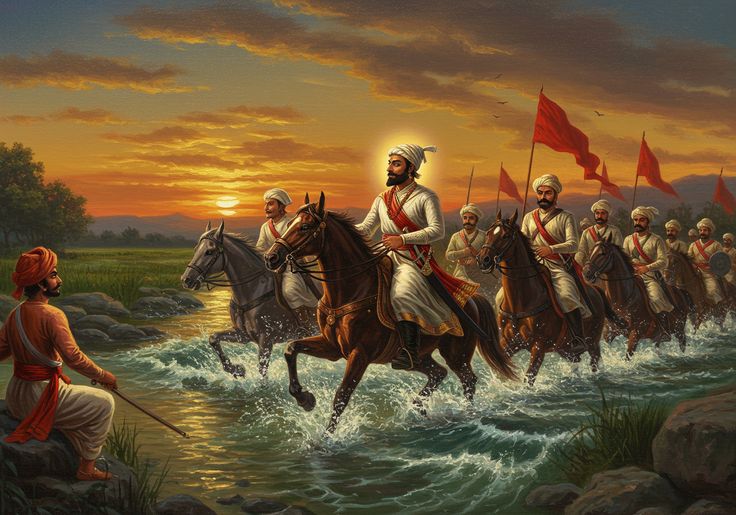
📚 References
- Jadunath Sarkar – Shivaji and His Times
- G.S. Sardesai – New History of the Marathas
- Shivaji Souvenir – Maharashtra Government Publication
🔚 Conclusion
The southern conquests of Shivaji Maharaj were a masterclass in strategy, diplomacy, and leadership. He didn’t just expand territory—he expanded the idea of Swarajya. His campaigns laid the foundation for a pan-Indian Maratha Empire, proving that self-rule, rooted in dharma and justice, could thrive beyond borders.
🛡️ The Final Days of Chhatrapati Shivaji Maharaj
April 3, 1680 – The Sunset of a Sovereign, The Rise of a Legacy
📅 Date & Place of Death
Date: April 3, 1680
Location: Raigad Fort, Maharashtra
On this solemn day, Chhatrapati Shivaji Maharaj, the architect of Hindavi Swarajya, passed away at Raigad Fort, the very seat of his empire. His death marked the end of a revolutionary era—but his dream lived on through his son, Sambhaji Maharaj.
🧠 Health Decline & Likely Cause
In early 1680, Shivaji Maharaj’s health began to deteriorate. Historical accounts suggest he may have suffered from:
- Malaria
- Dysentery
- Chronic fever
Despite the efforts of royal physicians, his condition worsened rapidly. The exact cause remains debated, but the decline was swift and irreversible.
👥 Companions at His Bedside
During his final hours, Shivaji Maharaj was surrounded by:
- Queen Soyarabai (his younger consort)
- Sambhaji Maharaj (his eldest son and heir)
- Senior ministers from the Ashtapradhan Mandal, including trusted aides and advisors
Their presence reflected the gravity of the moment and the respect he commanded till his last breath.
🗣️ Last Words
According to folklore and oral tradition, Shivaji Maharaj’s final words were:
“Swarajya is my birthright, and I shall have it.”
These words, echoing his lifelong mission, symbolize the unwavering spirit of resistance, pride, and purpose that defined his reign.
⚰️ State Funeral & Cremation
Shivaji Maharaj was cremated at Raigad Fort with full state honors over a three-day ceremony. The rituals included:
- Vedic chants
- Military salutes
- Public mourning across the kingdom
His samadhi (memorial) was built on-site and remains a national pilgrimage site, visited by thousands each year.
⚔️ Aftermath & Succession Struggle
Following Shivaji’s death:
- Soyarabai attempted to crown her son Rajaram, bypassing Sambhaji.
- A brief power struggle ensued.
- Ultimately, Sambhaji Maharaj emerged victorious and ascended the throne, continuing his father’s legacy.
🌟 Legacy
Shivaji Maharaj’s death was not merely the passing of a king—it was the end of an era. His contributions to:
- Governance
- Military innovation
- Cultural revival
- Swarajya ideology
remain timeless. He is remembered not just as a ruler, but as a symbol of courage, justice, and national pride.
“Chhatrapati Shivaji Maharaj is not just a historical figure—he is a living inspiration.”
📚 Final Thoughts & References
To understand Shivaji Maharaj’s final days and enduring legacy, historians refer to:
- Jadunath Sarkar – Shivaji and His Times
- Stewart Gordon – The Marathas 1600–1818
- British & Portuguese archival letters on Maratha diplomacy and succession
📘 Historical Sources & Recommended Books
- Shivaji and His Times – Jadunath Sarkar
- Shivaji the Great – G.S. Sardesai
- Shivaji: The Great Maratha – Ranjit Desai
- The Life of Shivaji Maharaj – N.S. Takakhav
- A History of the Maratha People – Kincaid & Parasnis
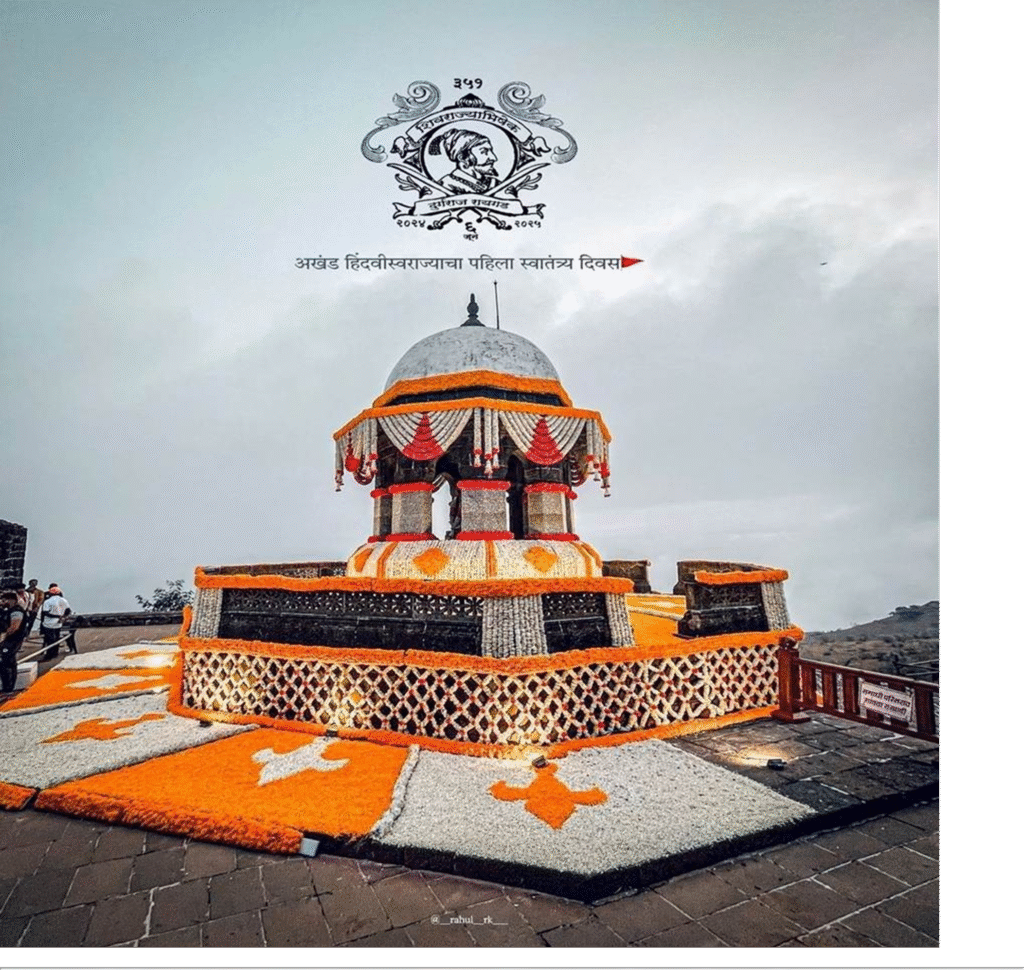
🏁 Final Conclusion: The Legacy That Commands Centuries
From Maval to Maharashtra, From Warrior to Chhatrapati
Chhatrapati Shivaji Maharaj was not just a king—he was a movement. From the daring raid on Shaista Khan to the strategic strike on Surat, from the coronation at Raigad to the southern conquests that expanded Swarajya’s reach, every chapter of his life was a masterclass in leadership, courage, and vision.
He built forts, but more importantly, he built faith. He fought battles, but more importantly, he fought for dignity. His administration was sharp, his diplomacy was bold, and his governance was rooted in justice. Whether it was the Ashtapradhan Mandal, the naval rise, or his final words on his deathbed—Shivaji Maharaj lived and died for Swarajya.
His coronation wasn’t just a royal ritual—it was a declaration that self-rule under dharma was possible. His southern campaigns weren’t just territorial—they were ideological. His final journey wasn’t just the end of a king—it was the beginning of a legacy.
Today, his name roars through history books, reels, blogs, and hearts. He is not just remembered—he is repeated. Every creator who speaks truth, every leader who defies injustice, every citizen who dreams of sovereignty carries a piece of Shivaji Maharaj’s fire.
“Swarajya wasn’t just his birthright—it became ours.”
Internal Links: 1.https://historyverse7.com/chhatrapati-shivaji-maharaj/
External Links: 1.https://en.wikipedia.org/wiki/Shivaji
📘 FAQ: Understanding Shivaji Maharaj’s Legacy
1. Why is Shivaji Maharaj considered a visionary ruler?
Ans: Because he combined military brilliance with administrative innovation. He built a navy, reformed taxation, and created a decentralized governance model that empowered local communities.
2. What was the significance of his coronation in 1674?
Ans: It was the formal birth of Hindavi Swarajya—a declaration that India could rule itself. The Vedic rituals, golden throne, and presence of scholars from across India made it a pan-national event.
3. Did Shivaji Maharaj fight only the Mughals?
Ans: No. He resisted multiple powers—Mughals, Adilshahi, Siddis, Portuguese, and British—through a mix of warfare, diplomacy, and strategic alliances.
4. What made his southern campaigns unique?
Ans: They were not just military expansions but cultural integrations. He respected local customs, built alliances, and extended Swarajya with minimal bloodshed.
5. How did Shivaji Maharaj die?
Ans: He passed away on April 3, 1680, at Raigad Fort, likely due to malaria or chronic fever. His final days were spent surrounded by family and ministers, and his last words echoed his lifelong mission.
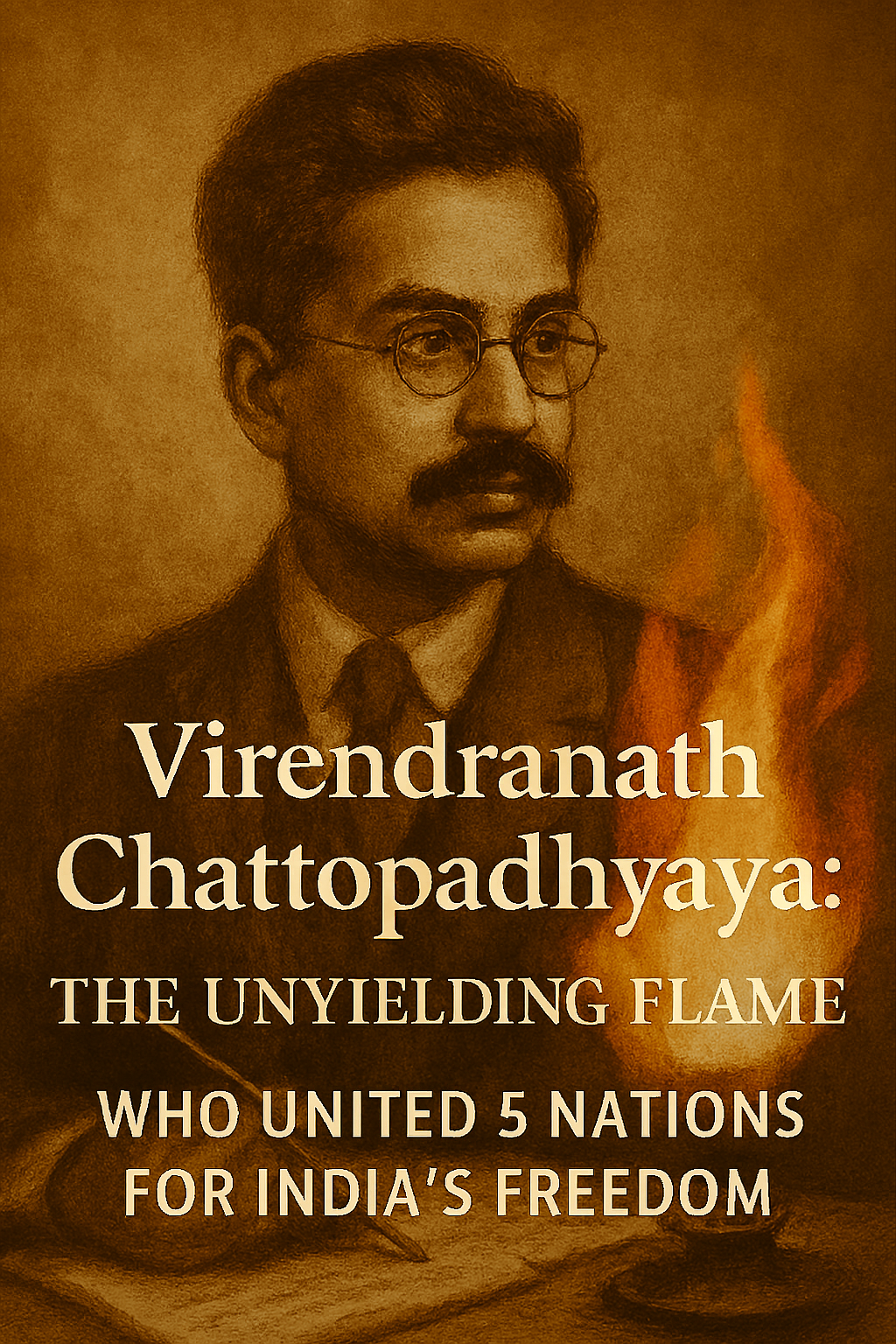
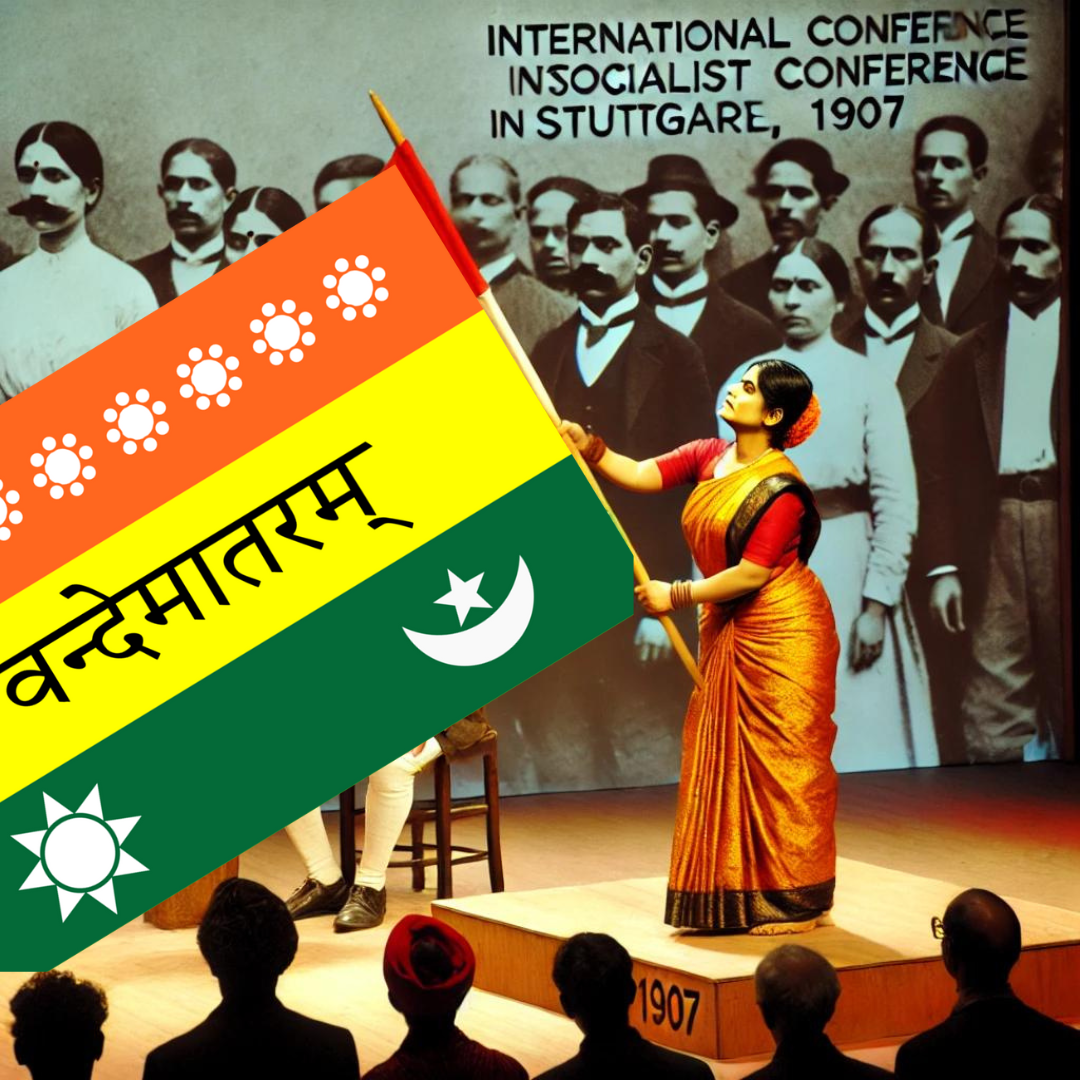
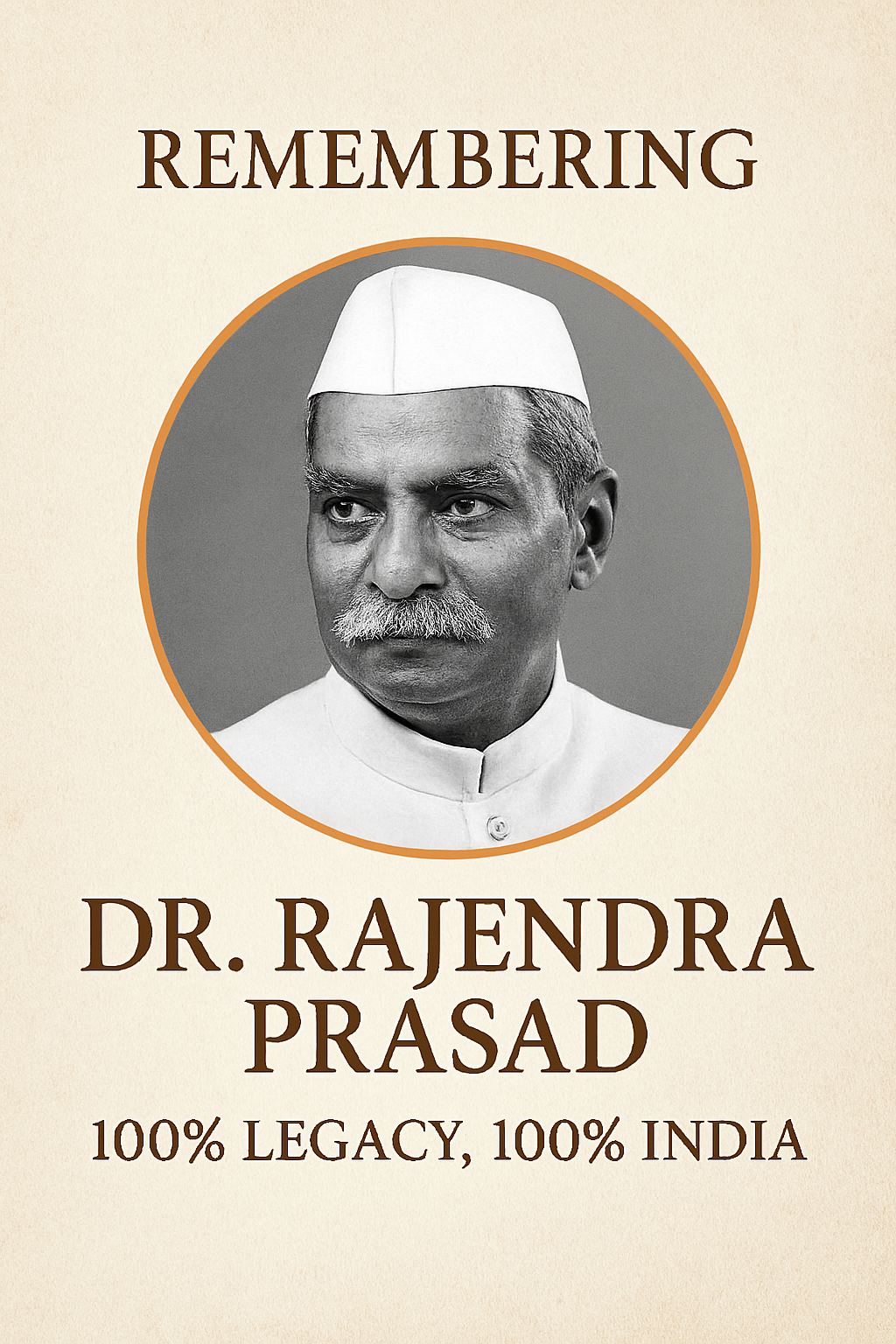
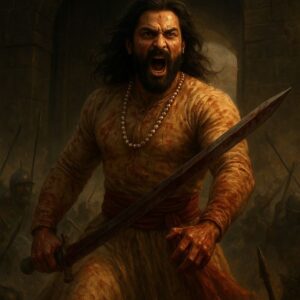
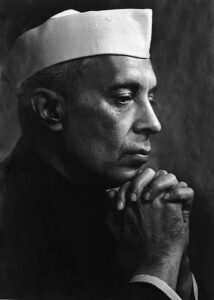

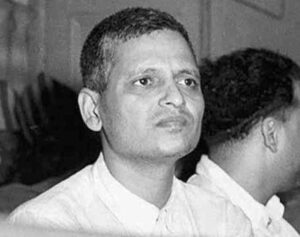
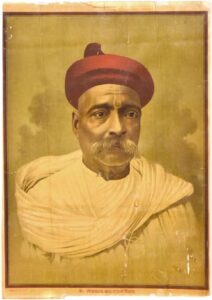
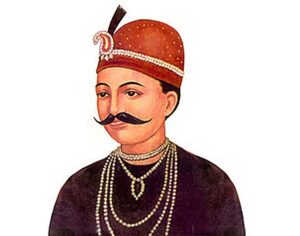
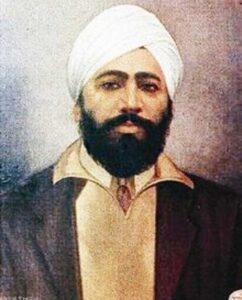
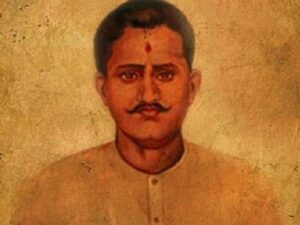
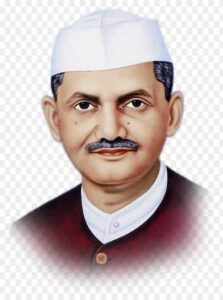
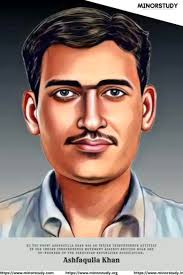
4 comments